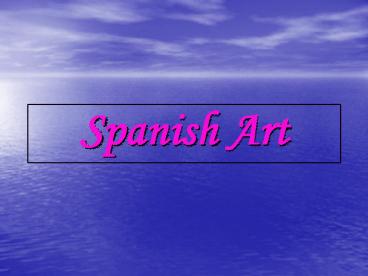Spanish Art - PowerPoint PPT Presentation
1 / 18
Title: Spanish Art
1
Spanish Art
2
Artists
- El Greco
- Diego Velázquez
- Francisco de Goya
- Pablo Picasso
- Salvador Dalí
3
El Greco
- El Greco was born in 1541 on the Greek
island of Crete. His real name is Domenikos
Theotocopoulos the name by which he is
universally known, El Greco, means the Greek.
Little is known of his younger years. When he
was in his 20s, he spent time studying with
Italian artists in Venice and Rome. Most of his
works consist of religious paintings and
portraits. - This is El Grecos self-portrait.
4
- In 1577 El Greco moved to Spain. He settled
in Toledo and spent the rest of his life there.
Many of his paintings are still located in
Toledo, although the Prado also houses quite a
few. The painting here is well-known and is
called The Burial of Count Orgaz. It hangs in the
Church of San Tomé in Toledo.
5
- While El Greco, unlike most other Spanish
artists, probably doesnt have a single painting
for which he is best known, he does have a
distinctive style. Notice the elongated face and
fingers in this painting, entitled The Repentant
Peter.
6
Diego Velázquez
- Diego Velázquez, born in Seville in 1599, was
a more conventional painter than most of the
other well-known Spanish artists. At the age of
11 or 12, he was apprenticed to a master painter,
and at the age of 18 he became qualified as a
master painter himself.
7
- During his youth he did religious paintings
and a type of scene paintings called bodegones.
At the age of 24 he became court painter, and
from then on he became known for his portraits.
He remained a court favorite for the rest of his
life. His most famous painting, Las Meninas
(The Maids of Honor), hangs in the Prado in
Madrid.
8
Francisco de Goya
- Francisco de Goya, frequently called the
father of modern art, was born in a village in
the province of Zaragoza in 1746. Goya followed
a more traditional path than Dalí and Picasso.
As a teenager, he entered the service of a local
artist. He later enrolled in the royal academy
and then became the court painter.
9
- Later, however, he became disillusioned with
the vanity of court life, and his paintings
became darker and more violent. In 1808
Spaniards rose up against French domination, and
many were executed. Goyas most famous painting
is called El 2 de mayo.
10
- When he was in his 70s, he became very ill,
and after he recovered, his works became even
darker. His most famous work from that period is
Saturn Devouring One of His Children. Goya died
in 1828.
11
Pablo Picasso
- Picasso, born in Málaga in 1881, was a rebel
from the start and, as a teenager, began to
frequent the Barcelona cafés where intellectuals
gathered. He soon went to Paris, the capital of
art, and soaked up the works of Manet, Gustave
Courbet, and Toulouse-Lautrec, whose sketchy
style impressed him greatly.
12
- Picasso went through several periods before
striking upon Cubism, the style for which he is
best known. Cubism is essentially the
fragmenting of three-dimensional forms into flat
areas of pattern and color, overlapping and
intertwining so that shapes and parts of the
human anatomy are seen from the front and back at
the same time. - This painting is called Portrait de
Ambroise Vollard.
13
- The bombing that resulted in the total
destruction of the town of Guernica during
Spains 1936-1939 civil war is the subject of
Picassos best-known work, entitled simply
Guernica. Picasso, completely opposed to Franco
(dictator from 1937 until his death in 1975),
refused to allow his painting into Spain as long
as Franco lived. For years it was housed in New
Yorks Museum of Modern Art, but now its in the
Reina Sofia museum in Madrid.
14
Salvador Dalí
- Salvador Dalí was born in 1904 in Figueras,
Spain, a small town about two hours from
Barcelona in the province of Catalonia. Although
Dalí excelled in his academic pursuits, he never
took final examinations, deeming that he had no
need for the type of education offered by formal
schooling.
15
- Dalí came under the influence of two forces
that shaped his philosophy and his art. The first
was Sigmund Freud's theory of the unconscious,
introduced to Dalí in Freud's book The
Interpretation of Dreams. The second was his
association with the French surrealists. When
Dalí visited Paris for the first time, he was
introduced to the leading surrealists in the
movement, but because of his lack of interest in
politics, he was eventually shunned by this group.
16
- Under the influence of the surrealist
movement, Dalí's artistic style crystal-ized into
the disturbing blend of precise realism and
dream-like fantasy that became his trade- mark.
Dalí often de-scribed his pictures as
hand-painted dream photographs and had certain
favorite and recur-ring images, such as the human
figure with half-open drawers protruding from it,
burning giraffes, and watches bent and flowing as
if made from melting wax. - This painting is called Woman with
Drawers.
17
- My personal favorite is Swans Reflecting
Elephants, which is on display at the Dalí museum
in Paris.
18
- Dalís most famous painting is called The
Persistence of Memory.































